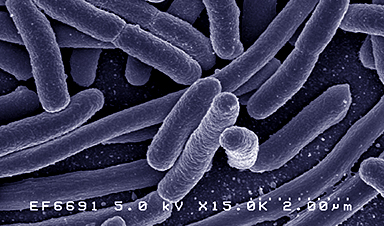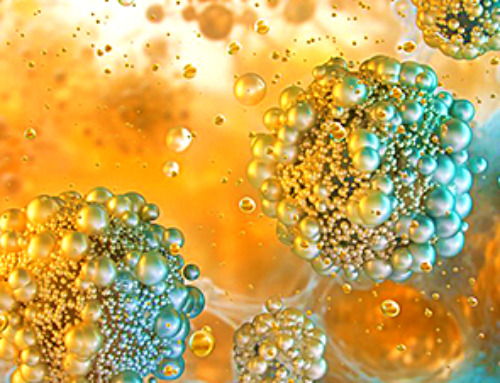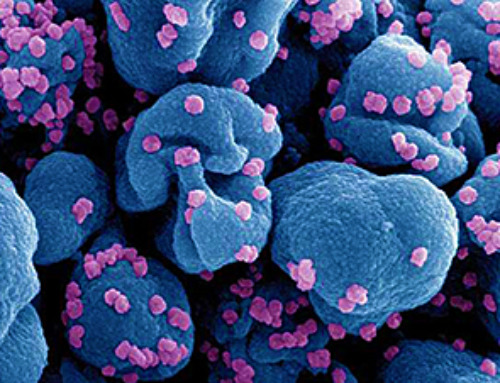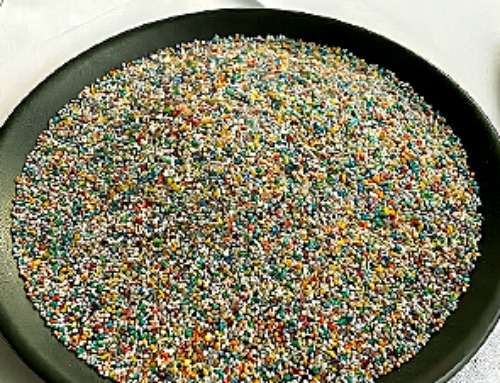Antibiotic-resistant bacteria have become a rapidly growing threat to public health. Each year, they account for more than 2.8 million infections, according to the U.S. Centers for Disease Control and Prevention. Without new antibiotics, even common injuries and infections harbor the potential to become lethal.
“The new polymers we synthesized could help fight antibiotic resistance in the future by providing antibacterial molecules that operate through a mechanism against which bacteria do not seem to develop resistance,” said Dr. Quentin Michaudel, an assistant professor in the Department of Chemistry and lead investigator in the research, published Dec. 11 in the Proceedings of the National Academy of Sciences.
Working at the interface of organic chemistry and polymer science, the Michaudel Laboratory was able to synthesize the new polymer by carefully designing a positively charged molecule that can be stitched many times to form a large molecule made of the same repeating charged motif using a carefully selected catalyst called AquaMet.
According to Michaudel, that catalyst proves key, given that it has to tolerate a high concentration of charges and also be water-soluble—a feature he describes as uncommon for this type of process.
“A common issue with antibacterial polymers is a lack of selectivity between bacteria and human cells when targeting the cellular membrane,” Michaudel explained. “The key is to strike a right balance between effectively inhibiting bacteria growth and killing several types of cells indiscriminately.”
Michaudel credits the multidisciplinary nature of scientific innovation and the generosity of dedicated researchers across the Texas A&M campus and country as factors in his team’s success in determining the perfect catalyst for their molecule assembly.
“This project was several years in the making and would not have been possible without the help of several groups, in addition to our UMass collaborators,” Michaudel said.
“For instance, we had to ship some samples to the Letteri Lab at the University of Virginia to determine the length of our polymers, which required the use of an instrument that few labs in the country have. We are also tremendously grateful to [biochemistry Ph.D. candidate] Nathan Williams and Dr. Jean-Philippe Pellois here at Texas A&M, who provided their expertise in our assessment of toxicity against red blood cells.”
Michaudel says the team will now focus on improving the activity of its polymers against bacteria—specifically, their selectivity for bacterial cells versus human cells—before moving on to in vivo assays.
“We are in the process of synthesizing a variety of analogs with that exciting goal in mind,” he said.
The team’s paper features Michaudel Lab member and Texas A&M chemistry Ph.D. graduate Dr. Sarah Hancock as first author. Other key contributors from the Michaudel Lab are chemistry graduate student An Tran, postdoctoral scholar Dr. Arunava Maity and former postdoctoral scholar Dr. Nattawut Yuntawattana, who is now an assistant professor of materials science at Kasetsart University in Thailand.
More information: Sarah N. Hancock et al, Ring-opening metathesis polymerization of N -methylpyridinium-fused norbornenes to access antibacterial main-chain cationic polymers, Proceedings of the National Academy of Sciences (2023). DOI: 10.1073/pnas.2311396120
News
Platelet-inspired nanoparticles could improve treatment of inflammatory diseases
Scientists have developed platelet-inspired nanoparticles that deliver anti-inflammatory drugs directly to brain-computer interface implants, doubling their effectiveness. Scientists have found a way to improve the performance of brain-computer interface (BCI) electrodes by delivering anti-inflammatory drugs directly [...]
After 150 years, a new chapter in cancer therapy is finally beginning
For decades, researchers have been looking for ways to destroy cancer cells in a targeted manner without further weakening the body. But for many patients whose immune system is severely impaired by chemotherapy or radiation, [...]
Older chemical libraries show promise for fighting resistant strains of COVID-19 virus
SARS‑CoV‑2, the virus that causes COVID-19, continues to mutate, with some newer strains becoming less responsive to current antiviral treatments like Paxlovid. Now, University of California San Diego scientists and an international team of [...]
Lower doses of immunotherapy for skin cancer give better results, study suggests
According to a new study, lower doses of approved immunotherapy for malignant melanoma can give better results against tumors, while reducing side effects. This is reported by researchers at Karolinska Institutet in the Journal of the National [...]
Researchers highlight five pathways through which microplastics can harm the brain
Microplastics could be fueling neurodegenerative diseases like Alzheimer's and Parkinson's, with a new study highlighting five ways microplastics can trigger inflammation and damage in the brain. More than 57 million people live with dementia, [...]
Tiny Metal Nanodots Obliterate Cancer Cells While Largely Sparing Healthy Tissue
Scientists have developed tiny metal-oxide particles that push cancer cells past their stress limits while sparing healthy tissue. An international team led by RMIT University has developed tiny particles called nanodots, crafted from a metallic compound, [...]
Gold Nanoclusters Could Supercharge Quantum Computers
Researchers found that gold “super atoms” can behave like the atoms in top-tier quantum systems—only far easier to scale. These tiny clusters can be customized at the molecular level, offering a powerful, tunable foundation [...]
A single shot of HPV vaccine may be enough to fight cervical cancer, study finds
WASHINGTON -- A single HPV vaccination appears just as effective as two doses at preventing the viral infection that causes cervical cancer, researchers reported Wednesday. HPV, or human papillomavirus, is very common and spread [...]
New technique overcomes technological barrier in 3D brain imaging
Scientists at the Swiss Light Source SLS have succeeded in mapping a piece of brain tissue in 3D at unprecedented resolution using X-rays, non-destructively. The breakthrough overcomes a long-standing technological barrier that had limited [...]
Scientists Uncover Hidden Blood Pattern in Long COVID
Researchers found persistent microclot and NET structures in Long COVID blood that may explain long-lasting symptoms. Researchers examining Long COVID have identified a structural connection between circulating microclots and neutrophil extracellular traps (NETs). The [...]
This Cellular Trick Helps Cancer Spread, but Could Also Stop It
Groups of normal cbiells can sense far into their surroundings, helping explain cancer cell migration. Understanding this ability could lead to new ways to limit tumor spread. The tale of the princess and the [...]
New mRNA therapy targets drug-resistant pneumonia
Bacteria that multiply on surfaces are a major headache in health care when they gain a foothold on, for example, implants or in catheters. Researchers at Chalmers University of Technology in Sweden have found [...]
Current Heart Health Guidelines Are Failing To Catch a Deadly Genetic Killer
New research reveals that standard screening misses most people with a common inherited cholesterol disorder. A Mayo Clinic study reports that current genetic screening guidelines overlook most people who have familial hypercholesterolemia, an inherited disorder that [...]
Scientists Identify the Evolutionary “Purpose” of Consciousness
Summary: Researchers at Ruhr University Bochum explore why consciousness evolved and why different species developed it in distinct ways. By comparing humans with birds, they show that complex awareness may arise through different neural architectures yet [...]
Novel mRNA therapy curbs antibiotic-resistant infections in preclinical lung models
Researchers at the Icahn School of Medicine at Mount Sinai and collaborators have reported early success with a novel mRNA-based therapy designed to combat antibiotic-resistant bacteria. The findings, published in Nature Biotechnology, show that in [...]
New skin-permeable polymer delivers insulin without needles
A breakthrough zwitterionic polymer slips through the skin’s toughest barriers, carrying insulin deep into tissue and normalizing blood sugar, offering patients a painless alternative to daily injections. A recent study published in the journal Nature examines [...]





















